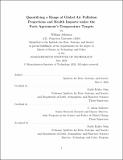| dc.contributor.advisor | Selin, Noelle Eckley | |
| dc.contributor.advisor | Schlosser, C. Adam | |
| dc.contributor.author | Atkinson, William | |
| dc.date.accessioned | 2022-08-29T16:24:41Z | |
| dc.date.available | 2022-08-29T16:24:41Z | |
| dc.date.issued | 2022-05 | |
| dc.date.submitted | 2022-06-22T14:59:36.486Z | |
| dc.identifier.uri | https://hdl.handle.net/1721.1/144974 | |
| dc.description.abstract | Air pollution is a key sustainability challenge with similar emissions sources to anthropogenic climate change – making it critical to assess the effect of climate and air quality actions on pollutant emissions, the resulting health impacts, and broader sustainability metrics. This thesis responds to these needs by developing a new Tool for Air Pollution Scenarios (TAPS) and applying it to example policy effects on emissions, health impacts, and alternative metrics that are consistent with a stock-based sustainability framework of inclusive wealth. In Chapter 2, we develop and implement TAPS with three components: recent global anthropogenic emissions inventories, emitting activity scenarios from the MIT Economic Projection and Policy Analysis model, and emissions intensity trends based on recent scenario data from the Greenhouse Gas – Air Pollution Interactions and Synergies model. Initial results show the limits of existing policy and the importance of different policy levers for different pollutants – including climate action to reduce fossil fuel related air pollutants (such as sulfur and nitrogen oxides), and other air quality controls to reduce pollutants such as ammonia and organic carbon. Chapter 3 connects the tool’s emissions results to health impacts, focusing on the difference between two pollution control scenarios under the common assumption that the Paris Agreement’s climate targets are met. We find major differences in ambient fine particulate matter concentrations as well as impacts on premature mortality and morbidity – showing that climate action alone does not guarantee a clean-air future. We also find distributional differences between different measures of national impacts, especially when comparing standard or monetized health endpoints with our alternative that focuses on healthy life years. Finally, Chapter 4 concludes with future considerations for scenario development, analytical choices, and stakeholder considerations for integrating the health impacts of air pollution into sustainability decisions. | |
| dc.publisher | Massachusetts Institute of Technology | |
| dc.rights | In Copyright - Educational Use Permitted | |
| dc.rights | Copyright MIT | |
| dc.rights.uri | http://rightsstatements.org/page/InC-EDU/1.0/ | |
| dc.title | Quantifying a Range of Global Air Pollution Projections and Health Impacts under the Paris Agreement’s Temperature Targets | |
| dc.type | Thesis | |
| dc.description.degree | S.M. | |
| dc.contributor.department | Massachusetts Institute of Technology. Institute for Data, Systems, and Society | |
| dc.identifier.orcid | https://orcid.org/0000-0002-6433-5227 | |
| mit.thesis.degree | Master | |
| thesis.degree.name | Master of Science in Technology and Policy | |
